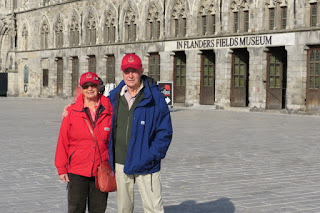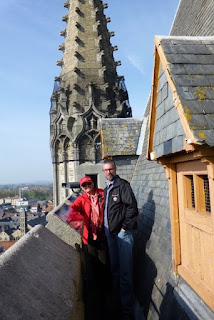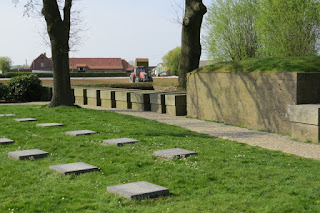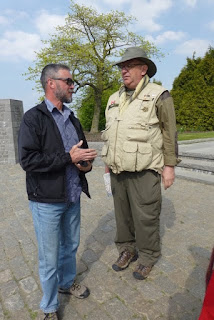A sleep-in morning for all, and after a leisurely breakfast we were over at Cloth Hall and the Flanders Field Museum for 1 1/2 hours at which time we climbed the 200 odd steps to the very top. On the way down we landed at the bell level just as the clock struck. Interesting to say the least.
We had a quick burger for lunch and then walked to our awaiting coach at 1.45 and we started our quick nip around some interesting WW I related things within 20 miles of Ypres.
First stop was Essex Farm where Colonel John McCrae wrote "In Flanders Field". He threw it away but his CO picked it up and suggested he reconsider it. It then appeared in Punch Magazine and the rest is history. We visited the Advanced Dressing Station where he worked, now a concrete bunker.
Craig then placed a poppy for his brother-in-law, Rob Parkes, in memory of his great grandfather who served in the Norwegian Army who was then mobilizing to protect their neutrality. Apparently he died in an accident.
The next stop was The Yorkshire Trench and Tunnels that were recently discovered when preparation for an Industrial park begant. Again, very interesting and gave us some idea of the close life in trenches, and the water levels. As an aside, the muddy fields in France and Flanders was due to two factors: one was the very heavy autumn rains for two years in a row, the second was because the heavy shelling completely destroyed the small ditches and drainage system that had been built up for generations.
We then stopped at St. Julian, or what is known as 'Vancouver Corner' where the Canadians took the first gas attack by the Germans, they stood their ground in spite of numerous casualties. The Germans attacked 15 minutes after the Canadians were gassed but they managed to beat off their attackers. The soldiers were from Vancouver and surrounds and as they were on the extreme left flank of the British Army, it became a 'Corner' The very poignant statue called 'The Brooding Soldier' faces the exact direction that the chlorine gas drifted their way that fateful day.
The last visit of the day, and the entire tour, was to a German Cemetery called 'Langemark'. The Germans have had a rough time regarding war cemeteries in western Europe. After WW II the Belgian farmers got tired of having their land used to house the dead of a two-time invader. As a result the 120 cemeteries then in use were consolidated into very view so most cemeteries were exhumed and had to be consolidated into a much smaller space. Most are buried in groups and even names have become lost. The younger generation is more forgiving and there was a bus load of Canadian kids there, many placing Canadian flags by the german plaques.
** ** **
This has been a very gruelling and sometimes very emotional tour for all of us. It certainly has driven home the magnitude of that war that they ended up calling 'The Great War'. I don't think I fully understood the scope of it until the last week.
** ** **
And what did we learn on this trip? The utter futility of war!
After breakfast and on the way to The Flanders Fields Museum.
After many, many, many steps we all made it to the top of the Cloth Hall Bell Tower.
As luck would have it, just as we entered the Bell Chamber on the way down, the clock struck the hour and we all did our various things: Fellette danced, Craig videos and Doug photographed.
Best Burger in Belgium…
This is for you Robert, Craig placing the poppy you gave him for your great grandfather in far off Norway, also a casualty of the war.
Trench buddies?
Looks great on a sunny day 100 years later.
Not many soldiers Craig's age would have experienced trench life.
The Brooding Soldier, at 'Vancouver Corner' in St. Julien Canadian Memorial where the fists gas attack took place. He faces into the direction that the gas drifted.
Fellette and Bill (a fellow Seaforth traveller) in the gardens at St. Julien
Profile of the monument.
Who is that young guy with Fellette?
Also a Seaforth battle, not far from here.
Spring here appears to be earlier than at home, but it was sure nice to see.
This monument was on Craig's wish list to see and we did not know we were coming here until we got onto the coach.
Nice to see that this younger generation bears no animosity. As the Chaplain said, 'Death is The Great Leveller'
Here we have a Belgian Farmer ploughing his field right next to the German Cemetery. He has given up several acres of his property to house dead invaders. What a bizarre world we live in.
Craig and the Seaforth Padre chatting about war medals.
This small grass plot holds the remains of over 25,00 Germans, in a mass grave. The soldier walking on the grass got yelled at by a Seaforth Sergeant for walking on the grave.





















No comments:
Post a Comment